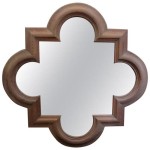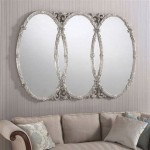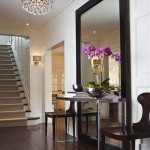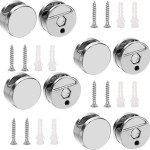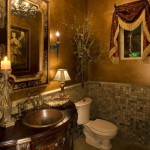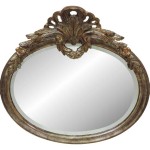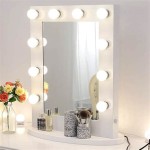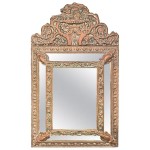Tin Framed Mirrors: A Reflective Blend of Style and History
Tin framed mirrors offer a unique blend of rustic charm and reflective practicality. Their distinctive aesthetic makes them suitable for various interior design styles, from farmhouse and industrial to eclectic and bohemian. This article explores the characteristics, benefits, and considerations associated with incorporating tin framed mirrors into a living space.
Material and Construction
The "tin" used in these frames is often tin-plated steel, a material historically chosen for its affordability and durability. The process involves coating a sheet of steel with a thin layer of tin, providing resistance to corrosion and a bright, silvery finish. Modern manufacturing methods can also utilize pure tin or other alloys like zinc, depending on the desired look and longevity of the frame. The frames themselves are often handcrafted, with artisans cutting, shaping, and soldering the metal into intricate designs or simple, clean lines.
The mirror portion typically consists of standard float glass, chosen for its smooth, distortion-free reflection. This glass is carefully fitted within the tin frame and secured using various methods, from metal clips and adhesives to more traditional techniques like glazing points. The backing of the mirror usually consists of a protective layer, such as MDF or plywood, to add stability and prevent damage to the reflective surface.
Aesthetic Versatility
One of the key appeals of tin framed mirrors lies in their aesthetic versatility. The malleable nature of tin allows for intricate detailing, resulting in frames ranging from simple geometric patterns to ornate floral motifs. This range of styles makes tin framed mirrors adaptable to diverse interior design schemes. In a rustic setting, a tin framed mirror can complement natural wood furniture and exposed brick walls, enhancing the vintage aesthetic. Within a modern or industrial space, the metallic sheen of the tin can provide a striking contrast against minimalist furnishings and concrete elements.
The finish of the tin frame also contributes to its versatility. Antiqued or distressed finishes lend a weathered, vintage appeal, while polished or painted surfaces create a more contemporary feel. Painted tin frames, in particular, offer an extensive range of color options, further expanding the mirror's ability to coordinate with existing decor. This adaptability allows tin framed mirrors to function as both statement pieces and subtle accents, depending on their size, design, and placement within a room.
Practical Considerations and Care
Beyond their aesthetic appeal, tin framed mirrors offer practical benefits. Their reflective surface can enhance natural light within a room, creating a brighter and more spacious feel. Strategically placed mirrors can also create the illusion of depth, making smaller rooms appear larger. Furthermore, the inherent durability of tin frames makes them a relatively low-maintenance decor choice.
However, certain considerations are essential for their long-term preservation. Excessive moisture can compromise the tin's protective layer, leading to rust. Therefore, tin framed mirrors are best suited for rooms with moderate humidity levels and should be avoided in areas prone to direct water exposure, such as bathrooms. Regular dusting with a soft cloth is typically sufficient for maintenance. Avoid abrasive cleaners, which can scratch the tin's surface. For stubborn dirt or fingerprints, a damp cloth with mild soap can be used, followed by thorough drying to prevent water spots or rust formation.
Integration into Interior Design
Tin framed mirrors seamlessly integrate into a variety of design styles. Their rustic appeal makes them a natural fit for farmhouse and cottage aesthetics, complementing distressed wood furniture and vintage textiles. In industrial settings, the metallic sheen of the tin harmonizes with exposed brick, metal piping, and reclaimed wood elements. The versatility of tin frames also extends to eclectic and bohemian interiors, where they can add a touch of unique character alongside globally inspired textiles and vintage finds.
The size and shape of the mirror also play a crucial role in its integration. Large, rectangular tin framed mirrors can serve as statement pieces above a fireplace or console table, while smaller, round or oval mirrors can create charming accents in hallways or bathrooms. Grouping multiple tin framed mirrors in varying sizes and shapes can also create a visually interesting focal point on a wall.

Vintage Painted Tin Framed Large Mirror Industrial County Non Ruby Lane

Punched Tin Wall Mirror Mexico Mexican Folk Art Horizontal Or Vertical 24 X30

Mexican Copper Tin Tile Mirrors Home Decor For

Tin Framed Wall Mirror Metal Oval Roof Mirrors Farmhouse Decor Rustic Antique Vintage

Arched Tin Framed Hand Hammered Mirror With Talavara Tiles Silver

27 Punched Tin Mirror Mexican Handmade Hacienda Style Folk Art

Large Vintage Deep Tin Framed Mirror 26 5 Wide X 31 Tall Was 0

Mexican Arched Tin Framed Mirror With Talavera Tiles Coffee Cream Color

Punched Tin Mirror Custom Made S

Antique Tin Ceiling Tile Framed Mirror Frame Frames

